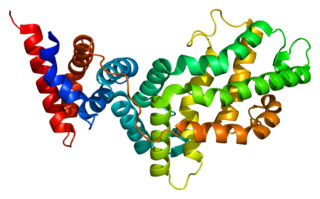Tyrosine-protein kinase 6 is an enzyme that in humans is encoded by the PTK6 gene. [5] [6] [7]
Tyrosine-protein kinase 6 is an enzyme that in humans is encoded by the PTK6 gene. [5] [6] [7]
Tyrosine-protein kinase 6—also known as BRK [7] (breast tumor kinase)—is a cytoplasmic non-receptor protein kinase which may function as an intracellular signal transducer in epithelial tissues. The encoded protein has been shown to undergo autophosphorylation. [7]
Overexpression of this gene in mammary epithelial cells leads to sensitization of the cells to epidermal growth factor and results in a partially transformed phenotype. Expression of this gene has been detected at low levels in some breast tumors but not in normal breast tissue. [7]
PTK6 has been shown to interact with STAP2 [8] and KHDRBS1. [9]

Hepatocyte growth factor receptor is a protein that in humans is encoded by the MET gene. The protein possesses tyrosine kinase activity. The primary single chain precursor protein is post-translationally cleaved to produce the alpha and beta subunits, which are disulfide linked to form the mature receptor.

Tyrosine-protein kinase transmembrane receptor ROR2, also known as neurotrophic tyrosine kinase, receptor-related 2, is a protein that in humans is encoded by the ROR2 gene located on position 9 of the long arm of chromosome 9. This protein is responsible for aspects of bone and cartilage growth. It is involved in Robinow syndrome and autosomal dominant brachydactyly type B. ROR2 is a member of the receptor tyrosine kinase-like orphan receptor (ROR) family.

Phosphatidylinositol 3-kinase regulatory subunit alpha is an enzyme that in humans is encoded by the PIK3R1 gene.

Receptor tyrosine-protein kinase erbB-3, also known as HER3, is a membrane bound protein that in humans is encoded by the ERBB3 gene.

RAS p21 protein activator 1 or RasGAP, also known as RASA1, is a 120-kDa cytosolic human protein that provides two principal activities:

KH domain-containing, RNA-binding, signal transduction-associated protein 1 is a protein that in humans is encoded by the KHDRBS1 gene.

GRB2-associated-binding protein 1 is a protein that in humans is encoded by the GAB1 gene.

M-phase inducer phosphatase 2 is an enzyme that in humans is encoded by the CDC25B gene.

CBL-B is an E3 ubiquitin-protein ligase that in humans is encoded by the CBLB gene. CBLB is a member of the CBL gene family.

Proto-oncogene tyrosine-protein kinase Yes is a non-receptor tyrosine kinase that in humans is encoded by the YES1 gene.

Tyrosine-protein kinase receptor UFO is an enzyme that in humans is encoded by the AXL gene. The gene was initially designated as UFO, in allusion to the unidentified function of this protein. However, in the years since its discovery, research into AXL's expression profile and mechanism has made it an increasingly attractive target, especially for cancer therapeutics. In recent years, AXL has emerged as a key facilitator of immune escape and drug-resistance by cancer cells, leading to aggressive and metastatic cancers.

Macrophage-stimulating protein receptor is a protein that in humans is encoded by the MST1R gene. MST1R is also known as RON kinase, named after the French city in which it was discovered. It is related to the c-MET receptor tyrosine kinase.

Cytoplasmic tyrosine-protein kinase BMX is an enzyme that in humans is encoded by the BMX gene.

SCRIB, also known as Scribble, SCRIBL, or Scribbled homolog (Drosophila), is a scaffold protein which in humans is encoded by the SCRIB gene. It was originally isolated in Drosophila melanogaster in a pathway (also known as the Scribble complex) with DLGAP5 (Discs large) and LLGL1 (Lethal giant larvae) as a tumor suppressor. In humans, SCRIB is found as a membrane protein and is involved in cell migration, cell polarity, and cell proliferation in epithelial cells. There is also strong evidence that SCRIB may play a role in cancer progression because of its strong homology to the Drosophila protein.

Docking protein 2 is a protein that in humans is encoded by the DOK2 gene.

Serine/threonine-protein kinase PLK2 is an enzyme that in humans is encoded by the PLK2 gene.

Large tumor suppressor kinase 2 (LATS2) is an enzyme that in humans is encoded by the LATS2 gene.

Membrane-associated guanylate kinase, WW and PDZ domain-containing protein 3 is an enzyme that in humans is encoded by the MAGI3 gene.

NUAK family SNF1-like kinase 1 also known as AMPK-related protein kinase 5 (ARK5) is an enzyme that in humans is encoded by the NUAK1 gene.

Signal-transducing adaptor protein 2 is a protein that in humans is encoded by the STAP2 gene.